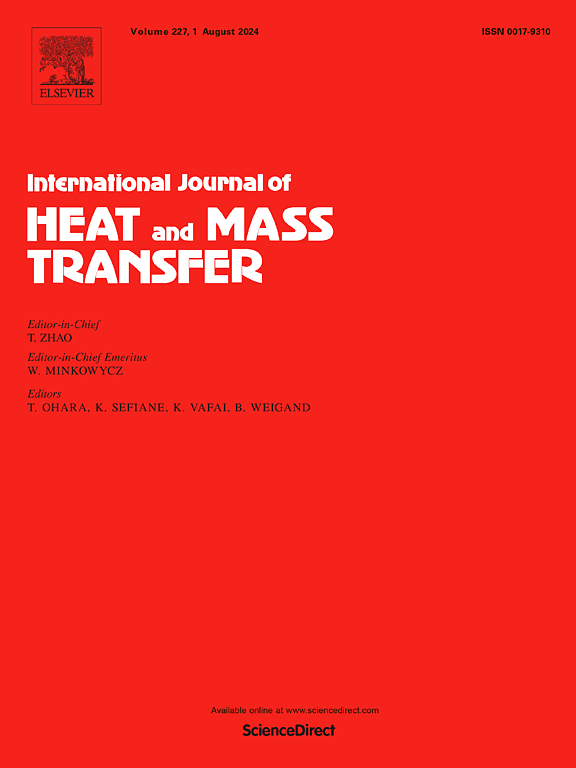Dynamic characteristics of droplet impact on heated surfaces near Leidenfrost temperature
IF 5.8
2区 工程技术
Q1 ENGINEERING, MECHANICAL
International Journal of Heat and Mass Transfer
Pub Date : 2024-11-26
DOI:10.1016/j.ijheatmasstransfer.2024.126459
引用次数: 0
Abstract
Spray cooling features with high heat flux and good temperature control ability, which has been widely used in industrial environments such as electronic devices and nuclear power plants. In this study, the transient process of droplet-wall collision under film and transition boiling conditions has been investigated experimentally via the high-speed shadowgraph imaging and state-of-the-art image processing techniques. Based on intensive test conditions, the impact morphology, number, size, trajectory, ejecting angle and velocity of secondary droplets are presented and analyzed comprehensively. In experiments, distilled water was the test fluid, with initial droplets at 3 ± 0.03 mm. Droplet collision velocity was calculated based on the center distance in two pre-collision frames. The Weber number changes from 15.4 to 104.2, while the wall temperature varies from 307.6 °C to 511.8 °C. The observed collision phenomena can be divided into four types, including rebound, rebound with secondary atomization, breakup with secondary atomization, and breakup. An Improved Cascade Gaussian Fitting method (ICGF), which performs well in the dense and mutually occlusive areas, is adopted for particle identification. The statistical results show that the secondary droplet diameter mainly distributes in the range of 0.02 mm to 0.2 mm under different Weber numbers. Under similar wall temperature conditions, the number of secondary droplets and the average diameter of secondary droplets increase with Weber number. Moreover, the separation mass ratio increased from 0.18 % to 2.29 %. Specifically, it is found that the amount and size of secondary droplets decrease significantly when the boiling mode transfers from transition to film. Based on the time-resolved shadowgraph images, a four-frame optimal estimation particle tracking algorithm is used to obtain the two-dimensional trajectory of the secondary droplets. The measured velocity distributes in the range of 0.3 m/s-4.0 m/s, mainly concentrating in the range of 0.5 m/s-2.0 m/s. The number and size variation with time is also analyzed, which indicates most of the secondary droplets are generated due to the strong instability in the transition boiling states.
液滴撞击接近莱顿弗罗斯特温度的受热表面的动态特性
喷雾冷却具有热通量高、温度控制能力强等特点,已被广泛应用于电子设备和核电站等工业环境中。本研究通过高速影图成像和先进的图像处理技术,对薄膜和过渡沸腾条件下液滴壁碰撞的瞬态过程进行了实验研究。在强化试验条件下,对二次液滴的碰撞形态、数量、大小、轨迹、喷射角度和速度进行了全面的展示和分析。实验以蒸馏水为测试流体,初始液滴为 3 ± 0.03 毫米。液滴碰撞速度是根据两个预碰撞帧的中心距计算得出的。韦伯数从 15.4 变化到 104.2,而壁温从 307.6 °C 变化到 511.8 °C。观察到的碰撞现象可分为四种类型,包括反弹、反弹与二次雾化、破裂与二次雾化以及破裂。粒子识别采用了改进级联高斯拟合方法(ICGF),该方法在密集区和相互遮挡区表现良好。统计结果表明,在不同韦伯数下,二次雾滴直径主要分布在 0.02 毫米到 0.2 毫米之间。在相似的壁温条件下,二次液滴的数量和平均直径随韦伯数的增加而增加。此外,分离质量比从 0.18 % 增加到 2.29 %。具体而言,当沸腾模式从过渡模式转变为薄膜模式时,二次液滴的数量和大小都会显著减少。根据时间分辨阴影图图像,使用四帧最优估计粒子跟踪算法获得了二次液滴的二维轨迹。测得的速度分布在 0.3 m/s-4.0 m/s 范围内,主要集中在 0.5 m/s-2.0 m/s 范围内。此外,还分析了二次液滴的数量和大小随时间的变化,结果表明大部分二次液滴是由于过渡沸腾态的强烈不稳定性而产生的。
本文章由计算机程序翻译,如有差异,请以英文原文为准。
求助全文
约1分钟内获得全文
求助全文
来源期刊
CiteScore
10.30
自引率
13.50%
发文量
1319
审稿时长
41 days
期刊介绍:
International Journal of Heat and Mass Transfer is the vehicle for the exchange of basic ideas in heat and mass transfer between research workers and engineers throughout the world. It focuses on both analytical and experimental research, with an emphasis on contributions which increase the basic understanding of transfer processes and their application to engineering problems.
Topics include:
-New methods of measuring and/or correlating transport-property data
-Energy engineering
-Environmental applications of heat and/or mass transfer

 求助内容:
求助内容: 应助结果提醒方式:
应助结果提醒方式:


